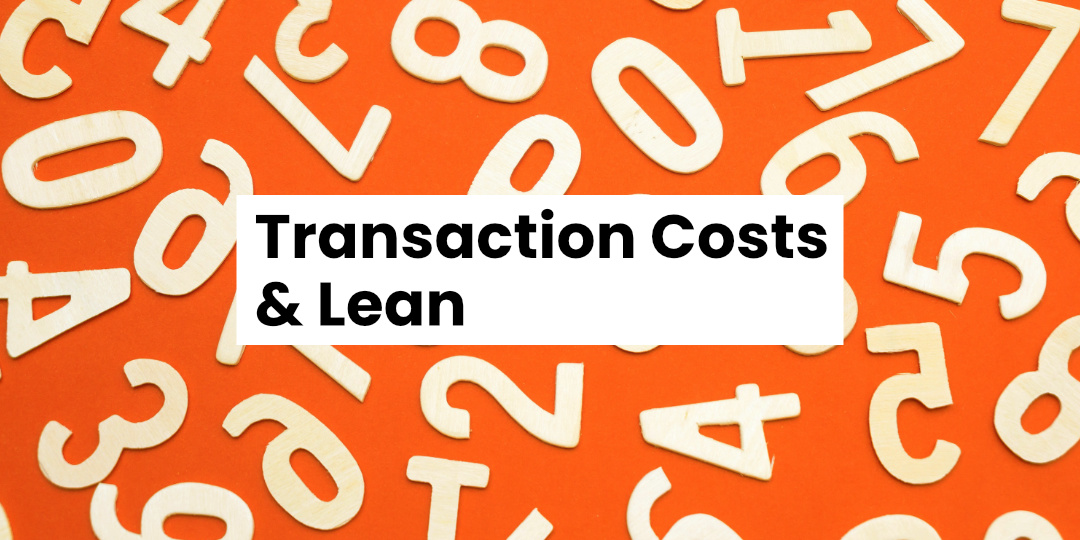How to Reduce Transactional Complexity with Lean
Have you ever wondered where all the overhead in your business is coming from? Transaction costs might be to blame, but luckily there are things you can do to minimize these. Lean methodology holds the keys to reducing the most readily addressable issues affecting transaction costs in your business.
At Veryable, we believe the current Lean model is in need of a refresh. It’s not that the basics are wrong, but rather, that—no surprise here—the digital revolution is changing everything.
In this article, you’ll learn what transaction costs are, how Lean helps reduce transaction costs, and how you can use this knowledge to make improvements to profitability now.
What are transaction costs?
In 1937, the economist Ronald Coase wrote an article where he tried to answer the question of why companies take the shape and the size they do. In a nutshell, his answer was that the firm represents an alternative to market transactions. In effect, firms “integrate” the role of markets as they acquire companies across their value chain. Coase concluded that firms grow as long as it is more effective for them to have transactions accomplished internally than to make them through the market.
In other words, the cost of transactions is key. This message was at the core of another influential article titled “The Hidden Factory”, which lamented the ever-growing costs of overhead in American industry. The authors estimated at the time that overhead made up 35% of production costs across U.S. industry.
The term “hidden factory” nowadays usually refers to the costs caused by insufficient quality, but that was not the focus of the original article. The authors explained that, although accounting systems base overhead rates on direct labor, material or machine hours, the true driver was transaction intensity.
The article identified five types of transactions behind the growth of overhead:
- Logistical transactions, which “order, execute, and confirm the movement of materials from one location to another.”
- Balancing transactions, which “ensure that the supplies of materials, labor, and capacity are equal to the demand (and which) result in the movement orders and authorizations that generate logistical transactions.”
- Quality transactions, which “extend far beyond what we usually think of as quality control, indirect engineering, and procurement to include the identification and communication of specifications, the certification that other transactions have taken place as they were supposed to, and the development and recording of relevant data.”
- Change transactions, which “update basic manufacturing information systems to accommodate changes in engineering designs, schedules, routings, standards, materials specifications, and bills of material (and) can occur over and over again.”
Transactions build up excessive costs that typically appear as overhead, which has always been a major headache for accountants, managers, and shareholders because it is, by definition, unassignable. So, if you’re trying to make decisions based on economic impact and 35% of your costs are overhead, that means you’re blind to how your decisions affect that 35%. Looking at it from the other side, you’re also blind to how 35% of your costs relate to performance and profits.
So, while Coase provided a good explanation for the creation of conglomerates in the 20th Century, the “Hidden Factory” concept may explain why, like many others before them, GE, Toshiba and J&J have moved away from conglomerates and are splitting into focused companies.
Again, we find transaction costs as a hidden but important aspect of business.
In their article, Miller and Vollman argued for three methods to reduce the weight of the Hidden Factory:
- Analyzing which transactions are necessary and improving the methods used to carry them out
- Increasing the stability of operations
- Relying on automation and systems integration
It did not escape their notice that Lean (or just-in-time, as it was called back then) immediately suggested a mechanism for reducing transaction costs!
Kaizen should target overhead activities that clutter the cost and revenue picture. You can do this by simplifying processes, reducing lead times, and making processes operate more “autonomously” through jidoka and pull systems.
How Lean reduces transaction costs
As companies become lean, they simplify their transaction landscape. Think of how materials flow faster inside value streams; at some point, lead times are short enough that inventory lasts no more than a month. This allows Lean accountants to switch to direct costing and quit recording inventory on balance sheet accounts.
Lean accounting pioneer Lantech freed up 1/8th of its accountants this way and got a much better view on their actual costs, since they weren’t “captured” in the balance sheet as inventory, to be later “released” to the P&L when the inventory was sold or reduced.
Similarly, Lean’s focus on built-in quality means that at some point it makes sense to backflush inventory transactions based on finished goods produced, without incurring unacceptably large errors.
While speeding up flow in a value stream results in lower costs, higher customer satisfaction and flexibility, it also does wonders for lowering the number and the costs of transactions. The difference is that you must take deliberate action to realize those benefits.
Consider the following ways to reduce transaction costs:
- Implementing Ship-to-line
- Using Pay-on-receipt
- Backflushing
- Consolidating work centers into a single line or flow cell
- Dedicating resources to a value stream
- Eliminating inspections for defects eliminated through poka yokes
- Eliminating ERP transactions for actions governed by Kanban
- Replacing complex controls by Visual Management
- Switching to direct costing
- Moving to autonomous teams (best described by Kiyoshi Suzaki as mini-enterprises)
All of these practices simplify the manufacturing process, which reduces transaction costs. When your CFO comes to you after a few years of successful Lean management and says “I have a problem: I can’t explain all this additional profit we’re making,” this is probably due to two things: continuous improvement driven by the shop floor and reduction in transactions.
Digital technology’s impact on transactional complexity
Through automation of data production, ingestion, processing, and representation, digital technologies offer new opportunities to increase the benefits of transactional data while greatly reducing their costs.
Veryable’s on-demand labor solution is an example of how the digital revolution complements Lean and reduces overhead, replaces planning by flexibility, and is extremely transaction-efficient: businesses don’t need to worry about hiring, data entry, insurance, or all the “hidden factory” that comes with more traditional labor management. To Miller and Vollman’s three methods for reducing the Hidden Factory, we can add one more: using digital marketplaces and digital tools to perform frictionless transactions at lowest costs.
Create a free business profile today to reduce your transaction costs further with on-demand labor.
For more information, visit our Lean Center of Excellence Homepage or our homepage for Continuous Improvement, Operational Excellence, and Lean Professionals.
Previous Posts
Trump 2.0 Week 12 Recap: Discussing The Reciprocal Tariff Pause, The Escalating Trade War With China, and More
The Future of Manufacturing and Logistics
Create a free business profile today to explore our platform.






